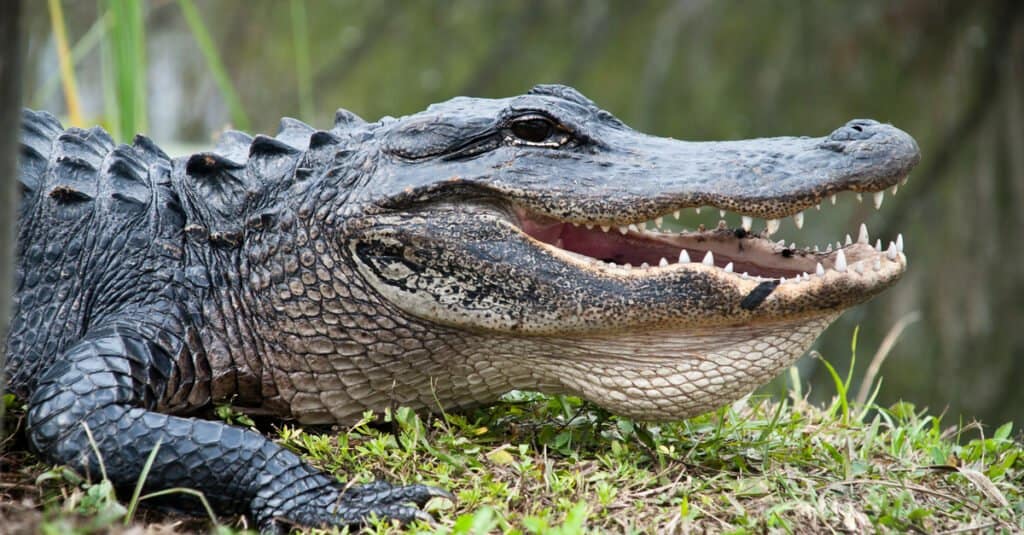Quick Answers:
- No, alligators are not dinosaurs.
- Alligators evolved from reptiles that existed before dinosaurs.
- Dinosaurs, Pterosaurs, and crocodilians came from the Archosaur group.
Dinosaurs and alligators lived at the same time and shared a common ancestor. But are alligators dinosaurs?
Alligators are not dinosaurs, though they belong to the same order as dinosaurs once did. Their ancestors were closely related to dinosaurs and walked the earth at the same time.
While dinosaurs went extinct, alligator ancestors went on to evolve into the alligators we see on Earth today. They haven’t even changed much since way back in the Mesozoic era.
In this article, we’ll discuss why alligators aren’t considered dinosaurs, how the two are related, and how alligators have evolved (and not evolved) over time.
What are Dinosaurs: Do they Exist Today?

Dinosaurs belonged to the order Archosauria, which also includes alligators.
©Elenarts/Shutterstock.com
Dinosaurs are extinct reptiles that lived in the Mesozoic era. They belonged to the order Archosauria, which contained Pterosaurs, Dinosaurs, and Crocodilians.
Dinosaurs had many shared characteristics with alligators, including being cold-blooded, egg-laying, and having a similar skull shape. Both dinosaurs and alligators are reptiles.
Because dinosaurs are extinct by definition, we know them only from fossils. No extant (or still living) creature is considered a dinosaur, even if they lived at the same time as dinosaurs.
Are Alligators Dinosaurs?
With all of the above out of the way, we can conclude: No, Alligators are not dinosaurs.
We know them as modern, living beings, not from fossils we unearthed and pieced together over time.
However, they are closely related and lived at the same time as dinosaurs. The alligators we know today are not much different than their ancestors, either!
Another interesting consideration is: would alligators be considered dinosaurs if they’d gone extinct at the same time?
It’s possible that, had alligators gone extinct, we would think of them as dinosaurs and lump them into the same category!
Today, scientists differentiate crocodilians from dinosaurs in a way that dinosaurs aren’t differentiated from one another, in part because we know way more about crocodilians from being able to witness them first-hand.
Archosaurs: Prehistoric Creatures of the Period

Dinosaurs, birds, and crocodilians all share a common ancestry.
©Orla/Shutterstock.com
Archosaurs are prehistoric creatures that belong to the order Archosauria. They can be broken into three groups:
- Pterosaurs were flying reptiles.
- Dinosaurs were a diverse group of reptiles including the biped, short-armed T-Rex, the spikey-backed Stegosaurus, and the long-necked Brontosaurus. All of these animals are now extinct.
- Crocodilians are the group that contains both crocodiles and alligators. Some species are extinct, but two alligator species, two gharials, 17 crocodiles, and six caiman species are still alive today.
The only living archosaurs today are birds and crocodilians. This means that birds and alligators are closely related to one another, despite their drastic differences!
They are also the closest living relatives to dinosaurs—though they, themselves, are not dinosaurs.
Alligators of Today vs Prehistoric Alligators

Alligators are little changed across time.
©RICIfoto/Shutterstock.com
Most creatures evolve slowly over time, and we can see big differences between the animals we know today and their ancestors from millions of years ago.
However, alligators seem to already be perfectly designed—because they haven’t changed much in the over 80 million years they’ve lived on Earth!
If you could see the ancestors of today’s alligators, you would recognize them instantly. Not only that, but scientists have found evidence that today’s species may be much older than we originally thought.
We don’t know exactly why the ancestors of the alligator survived dinosaur extinction, but it may be that they’re simply adaptable.
Evan Whiting, who has published multiple alligator studies, believes that their adaptability may be the reason they’re in trouble today.
As humans move into alligators’ habitats, we see them scaling fences, swimming in pools, and having a poor relationship with humans—either by way of human hunting or alligator attacks.
Whiting believes that understanding alligators can better our relationship and lead to a peaceful co-existence which includes conserving alligator habitat rather than taking over or destroying it.
Furthermore, alligators of today have another challenge to adapt to: climate change. It’s thought that alligators may begin to move north as their natural environment changes, and northern areas become more inhabitable. Currently, the cold northern temperatures keep them from venturing too far.
Brachychampsa: The First Alligator Species
The very first alligator species was known as Brachychampsa. They were around 8-10 feet (2.5-3 meters) in length, with powerful jaws and rounded teeth built for eating shells.
Due to studies of their jaws and teeth, researchers believe this alligator ate turtles.
This isn’t different to alligators of today, which eat turtles along with fish, birds, snakes, and small mammals.
However, today’s alligators have sharper teeth and less powerful jaws—though they still have a phenomenal bite force of over 2,000 pounds per square inch!
The photo featured at the top of this post is © Elenarts/Shutterstock.com
Thank you for reading! Have some feedback for us? Contact the AZ Animals editorial team.






